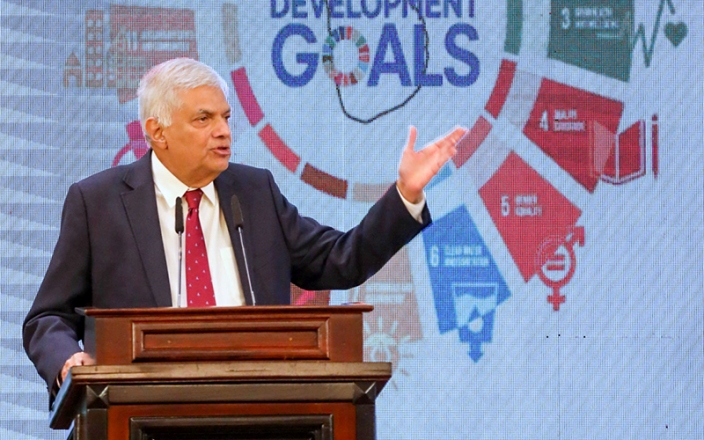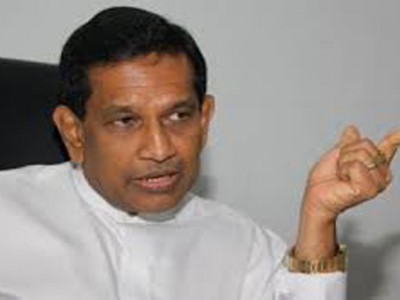(LANKAPUVATH | COLOMBO) – President Ranil Wickremesinghe, addressing the Forum on Sri Lanka Sustainable Development Trajectories & Pathways, expressed unwavering confidence in Sri Lanka’s potential to develop independently and alleviate the burden on external assistance.
“I think we in Sri Lanka should no longer think of asking others for help. But let’s make it on our own as many countries have done,” President Wickremesinghe asserted, underlining the nation’s determination to forge its path.
The President underscored the importance of diversifying financial resources beyond traditional channels. President Wickremesinghe emphasized that Sri Lanka’s reliance extends beyond financing solely from multilateral development banks. The engagement of the private sector, along with encouraging investments, has been identified as a crucial factor in generating the necessary funds to drive the country’s sustainable development initiatives.
In a bid to foster competitiveness and navigate economic challenges, President Wickremesinghe highlighted Sri Lanka’s proactive efforts to overhaul its economy. Drawing inspiration from successful models such as Thailand, Indonesia, and Vietnam, the nation seeks to attract foreign investments and capitalize on emerging markets.
President Wickremesinghe’s address at the Sustainable Development Forum conveyed an unwavering commitment to self-reliance, economic transformation, and sustainable growth, positioning Sri Lanka on a trajectory of progress and resilience.
Following is the full speech delivered by President Ranil Wickremesinghe;
“When the speakers before me were explaining the Sustainable Development Goals and what we have achieved so far, the question that arose in my mind was: what is the future?
I will be one of those participating in the discussions at the United Nations, which have been called for by the Secretary General. While discussing these issues with some of them and with some of my officials here, I had to raise a few questions that I thought I would also place before you. Where do we go from here? We have the Sustainable Development Goals that you all accepted, and now we are evaluating the results halfway through. But the world has changed a lot since then. In addition to the Sustainable Development Goals, we had the Paris Climate Summit and the Glasgow Summit, and thus the whole issue of climate change.
Furthermore, we are also meeting in the aftermath of the adverse impact of COVID-19 worldwide. Sri Lanka is one of the worst-affected because COVID itself resulted in Sri Lanka becoming bankrupt. However, every country has suffered. There has been a significant setback to the global economy. Even if we look at the situation today, what progress do we see? In Europe, it is still stagnant. The US has been luckier with growth taking place and the on-and-off rise and fall of economic performance. China is still in the process of recovery. So the engines of world growth have come to a halt.
So, what is the cost of all this for us? How do we find the financial resources for the Sustainable Development Goals? How do we find the financial resources for climate change mitigation? How do we find the financial resources for the global debt financing crisis? The engine itself, the engine of growth, has still not reached its fullest potential. It is in crisis. And with this engine of growth in crisis, we have also got to find the resources both for the Sustainable Development Goals and for climate change.
I am not speaking against these goals; these are goals that we have to fulfil. We have our commitment from the SDGs of 2030 to the climate change goals of 2050. Recently, the Secretary General called for an accelerated agenda. But all this requires the ability to find the resources.
Some thought that the developer would be good enough to fund it. However, they are not. They certainly haven’t come up with the resources. And at the moment, I don’t think they have the resources, given the problems they are facing. So where do we find it? Is the world still ready for a period of fast growth? No. So we are in the middle of another crisis. So, first, we have to look at how to find the resources, what resources are available. We rely not only on financing from the multilateral development banks, but also from the private sector. The private sector needs to invest, and the private sector needs to issue bonds. Will that succeed in the case of many countries? Some may not be prepared to accept it, and the private sector may find that other countries are not suitable for investment. So, we are leaving about one third to 40% out of that.
Then how does the rest grow? This is an issue we have to address. Where do we find the funding? Look at Sri Lanka. In 2019, we required an annual investment of 9% of GDP just to achieve the SDGs. In addition to this, we now have the climate change goals, and we are a country that’s bankrupt. So, where do we find the resources? This is a question that all of us have. As far as Sri Lanka is concerned, we will make the best effort. As a result of the debt crisis we’ve had, we are now taking measures to completely restructure the economy. We are following the path that Thailand, Indonesia, and Vietnam have taken, so that we become a highly competitive economy and learn to find our markets. We can no longer be the sheltered small economy that we were earlier. I hope that we will succeed, but it means reworking, starting from the beginning. We have to invest in new technologies and bring in foreign investment and capital. This is what we want to do because if we can develop on our own, then fewer resources will be needed for Sri Lanka, and more resources will be available elsewhere.
So let’s not be a burden. I think we in Sri Lanka should no longer think of asking others for help, but let’s make it on our own, just like many other countries have done. Take Vietnam, a country completely destroyed by war, which was still able to become a world power. There are many growing economies like Vietnam. There are numerous instances, and we are situated in the area of the Indian Ocean and the Pacific Ocean. We are in East Asia, Southeast Asia.
We are observing growth taking place. India holds potential for growth, and the Indian Ocean region is anticipated to be the next area of growth. So, we will strive to succeed on our own. However, can the whole world be supportive? They are after you. While Sri Lanka has its share of the Sri Lankan coast, it doesn’t necessarily mean that there will be ample resources available for others. With three distinct programs needing attention, it is prudent for us to consider an integrated approach to resolving this. We need to determine the areas that deserve immediate emphasis and those that can be addressed later.
I believe it’s time for all of us to review this situation. We should review the SDGs, assess climate change mitigation efforts, and examine the global debt crisis. The objective is not to abandon any of these but to bring them together and then find a way to regroup for the next phase. I intentionally use the term “regroup” because, in battle, after some time when your forces are scattered, you gather them all and regroup for the next assault. Similarly, we need to regroup, strategize, and move ahead. This is what I believe. This is what we have been contemplating, and I think it’s a serious option for us to consider.”
Meanwhile, addressing the forum, Treasury Secretary & Sustainable Development Council Chairman Mr. Mahinda Siriwardane said,
The midpoint of Sri Lanka’s pursuit of the 2030 Sustainable Development Goals (SDGs) prompts contemplation on progress, challenges, and commitments.
He said the forum’s significance lies in its potential to address fiscal constraints and debt issues that impede development aspirations. Globally, an extra $500 billion annually is essential for sustainable development. Sri Lanka, too, requires substantial resources for recovery and long-term progress, he added.
Mr. Siriwardane noted that fiscal stability and resilience are pivotal, accompanied by reshaping financial structures to bolster SDGs. Revenue-based fiscal consolidation efforts aim to restore fiscal and debt sustainability. Critical to this are fiscal institutions, institutional reforms in tax administration, expenditure management, and energy pricing.
“Environmental and social goals are aligned with government policies. Poverty reduction to 8% and unemployment to 5% by 2030 is targeted. The nation’s commitment to renewable energy is evident, aiming for 70% and 100% electricity from renewable sources by 2030 and 2050, respectively.”
He focussed on inclusive and equitable development, with the aim of leaving no one behind, adding that social safety nets, including the Welfare Benefits Program, support the vulnerable. Initiatives like the Roadmap for Sustainable Finance, Green Finance Taxonomy, SDG Investor Map and Green Bond Framework enhance SDG integration into the financial system.
Governance reforms and public financial management will continue, he said, adding that the new Public Financial Management Act with binding fiscal rules is being drafted. Enhanced powers and resources to investigate bribery and corruption have been enacted and a new Central Bank Act supports independent inflation targeting.
He also noted that efforts to align SDGs with the national budget process aim for targeted resource allocation. Reforms for economic stabilization and sustainable growth are pursued, alongside digitalization of public services and climate resilience investments.
Siriwardane appreciated collaboration and anticipates fruitful deliberations fostering partnerships and insights towards a sustainable Sri Lanka by 2030.
Ms. Chamindry Saparamadu, Director-General of the Sustainable Development Council, Mr. Arman Bidarbakht Nia, Head of the Statistical Data Management Unit of the United Nations Economic and Social Commission for Asia and the Pacific (UNESCAP), Ms. Azusa Kubota, Resident Representative of the United Nations Development Programme (UNDP), Mr. Marc-André Franche, Resident Coordinator of the United Nations (UN) in Sri Lanka, also spoke at this occasion. H.E Armida Salsiah Alisjahbana, Under-Secretary-General of the UN and Executive Secretary of UNESCAP, and Kanni Wignaraja, UN Assistant Secretary-General and UNDP Regional Bureau for Asia and the Pacific, also joined and delivered their messages via Zoom technology.
Prime Minister Dinesh Gunawardena, along with Ministers Ali Sabry, Pavithra Vanniarachchi, Mahinda Amaraweera, Keheliya Rambukwella, and State Ministers Shehan Semasinghe, Geetha Kumarasinghe, as well as President’s Senior Advisor on Climate Change Mr. Ruwan Wijewardena, Central Bank Governor Dr. Nandalal Weerasinghe, Secretary to the Ministry of Environment Dr. Anil Jasinghe, and Secretary to the Ministry of Energy U. K. Mapa Pathirana, along with Country Director of the Sri Lanka Resident Mission of the Asian Development Bank (ADB) Mr. Takafumi Kadono, and Chief Representative of the Japan International Cooperation Agency (JICA) Sri Lanka, University Vice Chancellors, Heads of Private and Public sectors, and officials of the National Council of Sustainable Development were present at this occasion.




